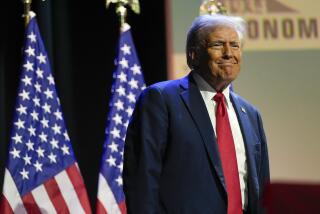Super Bowl takes U.S. pulse in seconds
- Share via
The Super Bowl, which apparently is some sort of sporting event on Feb. 7, is a unique media happening: a moment when the nation comes together to adjudicate the meaning of advertising and to ratify its absurd, over-scaled importance in our culture.
Yes, advertising has multiplexed and gone online, become socialized, product-integrated and user-generated. But the Super Bowl still creates the biggest single audience of the year. How advertisers choose to speak to that audience is the nearest thing we have to an instant cultural personality test. Don’t look now, U.S.A., but you’ve been profiled.
There will be a few hours on Feb. 8, I predict, when we look at one another and wonder about the wisdom of turning over so much of our psychic geography to these villains who just want to sell us stuff. Who put these voices in our heads? But then we’ll be back at the office, trying to watch GoDaddy.com’s too-hot-for-TV spot with Danica Patrick.
This is one of those moments when advertising reveals itself at the center of our culture and zeitgeist and is worthy of deeper thought. And the news is not good.
Before culture and even before sports, the Super Bowl is about business. For weeks, the advertising community has been buzzing about which companies are in the show (Doritos, Denny’s, Dockers) and which are not (General Motors, Ford, FedEx). Is it significant that the only domestic carmaker represented this year is the thoroughly troubled Chrysler, while upstart foreign nameplates such as Kia and Hyundai are shoveling vast amounts of cash through CBS’ transom? (Answer: yes.) What does it mean for the beverage business that Pepsi is riding the pine while Coke is still in the Big Game?
When enormous, category-defining incumbents like FedEx skip the Super Bowl, it’s hard not to take that as a sign of decline, or retreat. Super Bowl ad buys thus constitute a sort of futures market of corporate America.
Meanwhile, the price of a 30-second spot -- estimated to be about $2.5 million to $2.8 million, according to TNS Media Intelligence, down from 2009’s average of more than $3 million -- has come to be regarded as reliable an index of economic strength as durable goods or balance of trade. This is not a forecasting method Milton Friedman remotely anticipated.
As to whether the venerable, distinctly old-school Super Bowl buy is worth it in the redrawn media landscape, it depends. In the last two decades, the costs have accelerated well past the growth of the audience, which totaled about 100 million in 2009, according to Nielson. But the marketing return on investment equation is more subtle than eyeballs divided by dollars.
Companies with good “creative” -- industry shorthand for the cleverness and quality of an ad’s production -- will enjoy monumental word of mouth as America collectively judges, “Idol”-style, who had the best commercial. Dozens of news outlets will give users a chance to vote and give critics a chance to pick and pan. Buzz is, in a way, priceless.
Marketers have learned by now to leverage Super Bowl buys with a coordinated seek-and-persuade campaign online, where the ads will enjoy a longer shelf life and wag even more tongues.
Last year, online views of Super Bowl spots tallied 99.5 million, Advertising Age reported. That’s almost exactly the number of viewers of the televised event. In other words, marketers who geared up had the opportunity to double their marketing return on investment.
The online stock trading service E-Trade, for example, began posting its Super Bowl spots featuring a talking baby on YouTube in the days leading up to the big game in 2009.
E-Trade? Talking baby? You remember that, don’t you? You bet you do.
Culture critics might look at Super Bowl ads in a less-generous light, however. The event’s marquee advertising tends to scrape the bottom of whatever barrel in which we keep our collective wits.
Last year, Frito-Lay sponsored a contest in which regular folks could try their hand at making a commercial for its Doritos snack chips. If anybody could beat Budweiser and Coke in a viewer popularity contest, they could win a million dollars. The prize went to Indiana brothers Joe and Dave Herbert. Their spot ends with an office worker hurling a soothsaying orb into the crotch of his boss.
The most Tivo’d ad of last year’s Super Bowl was the GoDaddy.com’s ad “Enhancement,” with Danica Patrick, featuring buxom actresses in a courtroom denying they’d been “enhanced.” You stay classy, Super Bowl.
Reliably, the Super Bowl ads will generate controversy. The right-wing, anti-gay Focus on the Family organization this year managed to get an ad past the producers’ usual prohibition against controversial-cause advertising. The ad will soft-pedal the organization’s strident politics by featuring Heisman Trophy-winning, Florida Gators quarterback Tim Tebow and his mother, Pam. The ad will promote the theme “Celebrate family. Celebrate life.” That will be good for some ink.
And, since nobody else seems to have raised this issue yet, I will: Not a single Super Bowl ad speaks directly to the Latino market. This seems a grievous slight against an audience that represents an awful lot of money and potential goodwill for advertisers.
To take this year’s roster of advertisers as a sort of fractured mirror of America, consider an abbreviated list: Anheuser-Busch, Audi, Boost Mobile, Bridgestone, Cars.com, CareerBuilder (which is part-owned by Tribune Co., the parent company of the Los Angeles Times), Coke, Denny’s, Dockers, Hyundai, Kia, Mars, Paramount, Universal, Disney and Unilever’s Dove men’s care line.
The composite Super Bowl viewer is thus a beery, junk-food-eating, unemployed guy yakking away on his cellphone while driving his foreign car to the movies.
Enjoy the game.


